4.1 Project or conservation activities in water use.
4.1-1 Kasetsart University has appointed of the Board of Directors for Energy Management, to deciding the Policy Formulation, Implementation Plan and the University’s energy conservation guidelines (Figure 4.1-1)


(Figure 4.1-1 Appointment of Energy Management Committee)
4.1-2 Kasetsart University has the policy to organize activities or projects to conserve energy, water using in the workplace, public relations within department and through the website (Figure 4.1-2)
.




Public relations through the website of Kamphaeng Saen Campus
(Figure 4.1-2 Public Relations in Organizations)
4.1-3 Energy-saving campaign / Sports Personnel Program for health (Figure 4.1-3)




(Figure 4.1-3 Energy saving campaign / Sports Personnel Program for health)
4.1-4 Water-saving campaign and toilet paper reduction program (Figure 4.1-4)


(Figure 4.1-4 Water-saving campaign and toilet paper reduction program)
4.1-5 To reduce using water in toilet by filling water in 2 bottles water, placing the water bottles in the water tank at the back of the toilet. This method is not to obstruct the entrance of the water. Then close the rear tank lid. Try Pressing the toilet flush as usual. The water can be saved about 3 litres per each. (Figure 4.1-5)


(Figure 4.1-5 Reduce water use from toilet)
4.1-6 Water Management Project by controlling weed around the surrounding areas which helps tobalance the water conservation and doesn’t cause sewage in the canal and wastewater treatment. (Figure 4.1-6)



(Figure 4.1-6 control weed around the surrounding areas)
4.1-7 Enzyme Ionic Plasma Policy for Wastewater Treatment within Kasetsart University (Figure 4.1-7)


(Figure 4.1-7 Enzyme Ionic Plasma Policy for Wastewater Treatment)
4.1-8 Water Management Project can solve drainage clogs, clean up pipes / canals, and improve a drainage system for flood management (Figure 4.1-8)





(Figure 4.1-8 Water Management Project to solve drainage clogs, clean up pipes / canals)
4.1-9 To check the 150-horsepower pump system for life long service and to prevent repairiug frequently. All pumps should have the records of the maintenance in using and timetables for a punctual monitoring and maintenance. (Figure 4.1-9)


(Figure 4.1-9 Checking the pump system.)
4.1-10 Collection of rainwater
Precipitation reservoir for sterilization. Water-saving campaigns has been developed in using water saving tap (see Figure 4.1-10)
.
(Figure 4.1-10 rain water reservoirs)
- Collection of rainwater for watering vegetables in buildings ( Office of the Library) (Figure 4.1-10)
.
(Figure 4.1-10 Rainwater Collection)
4.1-11 Underground water storage tanks
Ngamwongwan parking lot 2 is equipped with underground water storage tanks in order to prevent potential land subsidence with the space saving and stable water temperature. (Figure 4.1-11)




(Figure 4.1-11 Underground water storage tanks)
4.1-12 Building ponds / lakes for keeping water
Kasetsart University Kamphaengsaen Campus builds the 7 wells of ponds and lakes for keeping water to use. Wells in the area are approximately 416 rai. One well in 130 rai can produce for tap water of 48,000 cubic meters / year. (Figure 4.1-12)
.
Well No. 1 in 150 rai can produce tap water of 48,000 cubic meters / year.


Well No. 2 in 50 rai Well No. 3 in 80 rai


Well No. 4 in 80 rai Well No. 5 in 80 rai


Well No. 6 in 70 rai Well No. 7 in 40 rai
(Figure 4.1-12 Water storage at Kamphaeng Saen Campus)
Kasetsart University Chalermphrakiat Sakon Nakhon Province Campus has 7 water reservoirs including Kalasin Reservoir, Nakhon Phanom Reservoir, Mukdahan Reservoir, Sakon Nakhon Reservoir, Nong Khai Reservoir and Udon Thani Reservoir. Total 1,400,000 cubic meters of water are collected from each reservoir for using in agricultural research areas (Figure 4.1-13).




(Picture 4.1-13 of the rain reservoir at Kasetsart University Chalermphrakiat Sakon Nakhon Province Campus)
